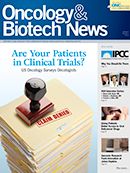Publication
Article
Oncology & Biotech News
Scientists Closer to Effectively Using Cord Blood to Treat Patients with Cancer
Author(s):
Scientists at Fred Hutchinson Cancer Research Center in Seattle, Washington, successfully tested a mechanism that increases the number of progenitor cells extracted from a unit of human umbilical cord blood. The laboratory method potentially solves the 1- to 2-month delay in myeloid engraftment after cord blood transplantation (CBT).
Click here to view as PDF.
Scientists at Fred Hutchinson Cancer Research Center in Seattle, Washington, successfully tested a mechanism that increases the number of progenitor cells extracted from a unit of human umbilical cord blood. The laboratory method potentially solves the 1- to 2-month delay in myeloid engraftment after cord blood transplantation (CBT). This delay, associated with increased transplant-related morbidity and mortality, currently discourages wider use of CBT for treating patients with leukemia and other hematologic malignancies.
Thirty percent of patients who need a transplant fail to find a donor match. Clinical studies suggest that umbilical cord blood stem cells do not need to match as precisely as stem cells from bone marrow and peripheral blood. Scientists have been unable to exploit this advantage, however, because cord blood contains about one-tenth the number of stem/progenitor cells as traditional transplant sources. This severely delays myeloid engraftment, leaving immune-compromised patients at an increased risk of developing life-threatening infections and death.
The Hutchinson Center scientists expanded the CD34+ hematopoietic stem cell count in units of cord blood to an average of 6 million cells per kilogram of the patient’s body weight. This massive increase over the standard 200,000 stems cells in cord blood brought the graft on par with bone marrow and peripheral blood.
In an ongoing phase I clinical trial, the enhanced cord blood units were administered to 10 patients (aged 3-43 y) with high-risk acute leukemia. Each patient received 1 unit of regular cord blood and 1 manipulated unit with an expanded cell count. The average time to engraftment for the expanded cord blood unit was 14 days after transplantation, which was 2 weeks shorter than the engraftment period for regular units. The expanded units also rapidly enhanced neutrophil recovery in the crucial period following transplantation, and 70% of patients remain alive with no evidence of disease and sustained, complete donor engraftment.
Nature Medicine
The study, published in , says further testing and technological improvements are necessary to verify the trial results. The authors said that if the cord blood procedures are approved in the future, minority patients would benefit greatly, because 95% never find suitable donor matches.
Irwin Bernstein, MD, a member of the Hutchinson Center’s Clinical Research Division, developed the method for expanding the stem cell count, which involves activating the Notch signaling pathway in the stem cells. Data were first published in 2000. It took another decade to translate the laboratory findings to patients in a clinical setting.
“The real ground-breaking aspect of this research is that we have shown that you can manipulate stem/progenitor cells in the lab with the goal of increasing their numbers. When given to a person, these cells can rapidly give rise to white blood cells and other components of the blood system,” said Colleen Delaney, MD, assistant member of the Hutchinson Center’s Clinical Research Division and an assistant professor in the Department of Pediatrics at the University of Washington School of Medicine.
Nature Medicine
Delaney C, Heimfeld S, Brashern-Stein C, et al. Notch-mediated expansion of human cord blood progenitor cells capable of rapid myeloid reconstitution. . 2010;16:232-236.

















%20(2)%201-Recovered-Recovered-Recovered-Recovered-Recovered-Recovered-Recovered-Recovered-Recovered-Recovered-Recovered-Recovered-Recovered-Recovered-Recovered-Recovered-Recovered.jpg?fit=crop&auto=format)
%20(2)%201-Recovered-Recovered-Recovered-Recovered-Recovered-Recovered-Recovered-Recovered-Recovered-Recovered-Recovered-Recovered-Recovered-Recovered-Recovered-Recovered-Recovered.jpg?fit=crop&auto=format)
